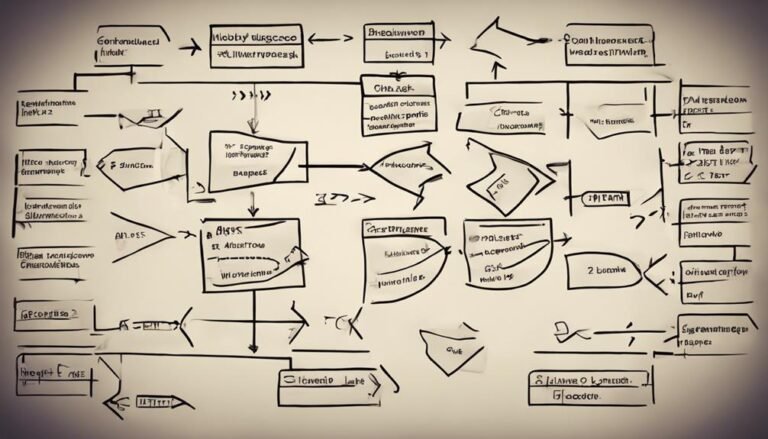Business Analytics for Operational Efficiency
In today's dynamic business landscape, the pursuit of operational efficiency is a constant endeavor for organizations striving to stay ahead. Business analytics has emerged as a pivotal tool in this quest, offering insights that enable informed decision-making and strategic planning.
By harnessing the power of data, companies can uncover hidden patterns, identify bottlenecks, and optimize processes to drive performance improvements. The integration of analytics into operational processes not only streamlines workflows but also enhances adaptability and responsiveness in an increasingly competitive market.
The possibilities that data-driven insights hold for operational efficiency are vast and transformative, promising to revolutionize the way businesses operate in the digital age.
Key Takeaways
- Enhance decision-making with predictive modeling and data visualization.
- Implement efficiency metrics like time management and resource allocation.
- Drive data-driven decisions for operational effectiveness and competitiveness.
- Reduce operational costs through automation, negotiation, and optimization techniques.
Importance of Business Analytics
Business analytics plays a pivotal role in enhancing organizational decision-making processes by providing insightful data-driven insights. Predictive modeling is a key component of business analytics that helps companies forecast future trends and outcomes based on historical data analysis. By leveraging predictive modeling techniques, organizations can anticipate customer behavior, market trends, and potential risks, allowing them to make proactive decisions to stay ahead of the curve.
Data visualization is another essential aspect of business analytics that transforms complex data sets into visually appealing and easy-to-understand graphs, charts, and dashboards. Through data visualization tools, such as interactive dashboards and heat maps, businesses can quickly identify patterns, trends, and outliers within their data, enabling them to make informed decisions efficiently.
Key Metrics for Efficiency
Efficiency in business operations relies heavily on the strategic management of time and resources.
Time management strategies ensure that tasks are completed promptly, while resource utilization analysis helps optimize the use of available resources.
Time Management Strategies
Implementing effective time management strategies is crucial for optimizing operational processes and achieving peak performance in business analytics. Prioritizing tasks and utilizing productivity techniques are essential components of efficient time management.
By identifying key tasks and focusing on high-value activities, businesses can streamline their operations and enhance productivity. Time tracking and the use of efficiency tools play a vital role in monitoring progress, identifying bottlenecks, and improving overall workflow.
Leveraging tools such as time tracking software, task management apps, and scheduling tools can help teams stay organized and make better use of their time. These strategies not only boost efficiency but also contribute to better decision-making and improved outcomes in business analytics.
Resource Utilization Analysis
Optimizing resource utilization through strategic analysis of key metrics is paramount for enhancing operational efficiency in business analytics. Efficient resource allocation and capacity planning are essential components in achieving this optimization.
Here are three key metrics to consider:
- Resource Allocation Efficiency: Assess how effectively resources are being distributed across projects or departments to ensure optimal utilization.
- Capacity Utilization Rate: Measure the percentage of available capacity that is currently being utilized to identify under or over-utilization issues.
- Resource Productivity: Evaluate the output generated per unit of resource input to gauge the efficiency of resource utilization strategies.
Data-Driven Decision Making
Utilizing data-driven approaches in decision-making processes is paramount for organizations striving to enhance their operational effectiveness and competitiveness. By leveraging data visualization techniques and predictive modeling, businesses can extract valuable insights from their data to make informed decisions. Data visualization enables stakeholders to easily interpret complex data sets through graphical representations, facilitating quick and effective decision-making. On the other hand, predictive modeling uses historical data to forecast future trends, helping organizations anticipate market changes and plan accordingly.
| Data-Driven Decision Making | |
|---|---|
| 1. Enhances operational effectiveness | 2. Improves competitiveness |
| 3. Enables quick decision-making | 4. Facilitates trend forecasting |
| 5. Supports informed planning |
Operational Cost Reduction Strategies
To enhance operational efficiency and maximize profitability, organizations must strategically identify and implement cost reduction strategies. By implementing cost-saving techniques, businesses can streamline their operations and improve their bottom line.
Here are three key strategies for reducing operational costs and enhancing efficiency:
- Process Automation: Automating repetitive tasks can significantly reduce labor costs and minimize human errors. By implementing software solutions or robotics to handle routine processes, organizations can increase efficiency and reallocate human resources to more strategic tasks.
- Vendor Negotiation: Regularly reviewing vendor contracts and negotiating better terms can lead to cost savings. Organizations should explore bulk discounts, payment discounts, or renegotiating contracts to ensure they are getting the best possible rates for goods and services.
- Energy Efficiency Improvements: Investing in energy-efficient technologies and practices can lead to long-term cost savings. Simple changes like switching to LED lighting, optimizing heating and cooling systems, or using energy-efficient equipment can reduce utility expenses and enhance operational efficiency.
Performance Optimization Techniques
In pursuit of operational efficiency beyond cost reduction measures, organizations can strategically implement performance optimization techniques to enhance overall effectiveness and productivity. Efficiency enhancement and performance improvement are crucial aspects of organizational success.
By analyzing key performance indicators (KPIs) and using tools like business intelligence and data analytics, companies can identify bottlenecks, streamline processes, and allocate resources more effectively. Implementing lean methodologies, such as Six Sigma or Kaizen, can help in eliminating waste and improving quality, leading to enhanced performance.
Additionally, investing in employee training and development programs can boost skills and competencies, ultimately contributing to improved performance levels across the organization. Continuous monitoring and feedback mechanisms play a vital role in identifying areas for improvement and ensuring that performance optimization efforts are yielding the desired results.
Implementing Predictive Analytics
Implementing predictive analytics in operational frameworks enhances decision-making capabilities through data-driven insights and forecasting models. This strategic approach leverages advanced techniques to extract valuable information from historical data and identify patterns for future outcomes.
To delve deeper into this topic, consider the following key aspects:
- Predictive Modeling: Utilizing predictive modeling techniques allows businesses to forecast trends, behaviors, and outcomes based on historical data analysis. By building sophisticated models, organizations can make informed decisions and optimize their operational strategies.
- Data Visualization: Visualizing data plays a crucial role in predictive analytics by providing stakeholders with intuitive representations of complex information. Through interactive graphs, charts, and dashboards, decision-makers can easily interpret trends and patterns, enabling faster and more accurate decision-making.
- Machine Learning and Trend Analysis: Incorporating machine learning algorithms enables businesses to perform in-depth trend analysis, identifying correlations and dependencies within datasets. By leveraging these technologies, organizations can uncover hidden insights and gain a competitive edge in the market.
Case Studies on Analytics Success
The integration of data-driven decision-making processes is fundamental to enhancing operational efficiency.
By analyzing performance metrics, organizations can identify areas for improvement and implement strategic changes.
Case studies on analytics success provide valuable insights into the practical application of business analytics for optimizing operations.
Data-driven Decisions
Utilizing data-driven insights has become a pivotal strategy for businesses seeking to enhance operational efficiency through informed decision-making. By leveraging advanced analytics techniques, organizations can extract valuable information from their data to drive success.
Below are key aspects illustrating the importance of data-driven decisions:
- Data Visualization Techniques: Visualizing data through graphs, charts, and dashboards can help stakeholders grasp complex information quickly and make more informed decisions.
- Predictive Modeling: By using historical data and statistical algorithms, businesses can predict future trends and outcomes, enabling proactive decision-making and resource optimization.
- Machine Learning Applications: Implementing machine learning algorithms can automate data analysis processes, leading to more accurate insights and improved decision outcomes.
Performance Metrics
To showcase the tangible impact of data-driven decisions on operational efficiency, examining real-world case studies that highlight the successful application of performance metrics in business analytics is imperative. Efficiency benchmarks and performance tracking play a vital role in operations analysis, enabling businesses to evaluate their performance against set standards and identify areas for improvement.
Enhancing Process Automation
Incorporating advanced automation technologies can significantly streamline operational processes and drive efficiency gains within organizations. When looking to enhance process automation, businesses can reap various benefits and achieve notable efficiency enhancements. Here are three key aspects to consider:
- Cost Reduction: Automation helps in reducing labor costs by eliminating repetitive manual tasks, allowing employees to focus on more strategic activities. This cost-saving aspect can positively impact the bottom line of a business.
- Improved Accuracy: Automation minimizes the risk of human error that can occur during manual data entry or routine processes. This enhanced accuracy leads to better decision-making and overall operational efficiency.
- Faster Processing: By automating workflows and tasks, organizations can accelerate the speed at which processes are completed. This increased efficiency not only saves time but also enables quicker responses to customer demands and market changes.
Efficiently leveraging automation technologies can pave the way for smoother operations and improved productivity within a business ecosystem.
Leveraging Real-Time Data Analysis
How can organizations harness the power of real-time data analysis to optimize decision-making and operational performance?
Real-time data analysis allows businesses to gain immediate insights into their operations, enabling them to make informed decisions promptly. By leveraging data visualization techniques, organizations can transform complex data sets into easily understandable visual representations, facilitating quick identification of trends, patterns, and anomalies. This real-time visibility into key performance indicators empowers decision-makers to respond swiftly to changing conditions and make adjustments as needed to improve efficiency and productivity.
Real-time insights derived from data analysis enable organizations to proactively address issues, capitalize on opportunities, and enhance overall operational performance. Through continuous monitoring of real-time data streams, businesses can identify bottlenecks, streamline processes, and optimize resource allocation in a timely manner. By incorporating data visualization techniques, such as dashboards and interactive reports, organizations can ensure that stakeholders at all levels have access to the information they need to drive operational excellence. Leveraging real-time data analysis is essential for staying competitive in today's fast-paced business environment.
Continuous Improvement Initiatives
Continuous improvement initiatives are vital in enhancing organizational performance.
Process optimization strategies play a key role in streamlining operations and boosting efficiency.
Similarly, data-driven decision making empowers businesses to make informed choices that drive continuous improvement efforts.
Process Optimization Strategies
Efficient process optimization strategies are essential for enhancing operational performance and achieving continuous improvement initiatives in businesses. When aiming for operational excellence, incorporating lean methodology and emphasizing process efficiency through workflow automation are crucial steps to streamline operations.
To achieve this, businesses can implement the following strategies:
- Value Stream Mapping: Identify and eliminate non-value-added steps in processes to enhance efficiency.
- Kaizen Events: Conduct regular improvement events involving employees to drive continuous enhancements.
- Standard Operating Procedures (SOPs): Develop and maintain detailed SOPs to ensure consistency and quality in operations.
Data-Driven Decision Making
Data-driven decision making plays a pivotal role in driving continuous improvement initiatives within businesses, providing valuable insights for optimizing operational efficiency. By utilizing data visualization techniques and predictive modeling, organizations can make informed decisions that lead to enhanced processes and outcomes.
| Data Visualization | Predictive Modeling |
|---|---|
| – Graphs and charts | – Forecasting future trends |
| – Dashboard analytics | – Identifying potential risks |
| – Heatmaps | – Anticipating customer behavior |
| – Interactive reports | – Optimizing resource allocation |
These tools enable companies to streamline operations, identify areas for enhancement, and proactively address challenges. Embracing data-driven decision-making empowers businesses to stay ahead of the competition and adapt to evolving market demands effectively.
Conclusion
In conclusion, business analytics plays a crucial role in enhancing operational efficiency by providing insights into key metrics. This enables data-driven decision making and the implementation of cost reduction strategies.
Leveraging real-time data analysis and continuous improvement initiatives can further optimize performance and streamline processes. As the saying goes, 'knowledge is power.' In the realm of operational efficiency, leveraging analytics is essential for organizations to stay competitive and achieve sustainable success.







